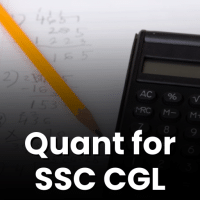SSC CGL Exam > SSC CGL Questions > There are 4 terms in an A.P. such that the su...
Start Learning for Free
There are 4 terms in an A.P. such that the sum of two means is 110 and product of their extremes is 2125. The 3rd term is (SSC Sub. Ins. 2012)
- a)65
- b)75
- c)55
- d)45
Correct answer is option 'A'. Can you explain this answer?
Most Upvoted Answer
There are 4 terms in an A.P. such that the sum of two means is 110 and...
Let the 4 terms in A.P are a – 3d, a – d, a + d, a + 3d
According to question
a – d + a + d = 110 ... (1)
(a – 3d) (a + 3d) = 2125 ... (2)
From equation (1)
a – d + a + d = 110
2a = 110 ⇒ a = 55
From equation (2)
(a – 3d) (a + 3d) = 2125
⇒ a2 – 9d2 = 2125
⇒ (55)2 – 9d2 = 2125
⇒ 3025 – 9d2 = 2125
⇒ 900 = 9d2 ⇒ d2 = 100 ⇒ d = 10
∴ a = 55, d = + 10
series would be :
25, 45, 65, 85
IIIrd term would be 65.
According to question
a – d + a + d = 110 ... (1)
(a – 3d) (a + 3d) = 2125 ... (2)
From equation (1)
a – d + a + d = 110
2a = 110 ⇒ a = 55
From equation (2)
(a – 3d) (a + 3d) = 2125
⇒ a2 – 9d2 = 2125
⇒ (55)2 – 9d2 = 2125
⇒ 3025 – 9d2 = 2125
⇒ 900 = 9d2 ⇒ d2 = 100 ⇒ d = 10
∴ a = 55, d = + 10
series would be :
25, 45, 65, 85
IIIrd term would be 65.
Free Test
FREE
| Start Free Test |
Community Answer
There are 4 terms in an A.P. such that the sum of two means is 110 and...
Understanding the Problem
In an arithmetic progression (A.P.), we have four terms: a, b, c, and d, where:
- a: first term
- b: second term (first mean)
- c: third term (second mean)
- d: fourth term
The properties given are:
- The sum of the two means (b + c) is 110.
- The product of the extremes (a * d) is 2125.
Step 1: Expressing Terms in A.P.
In an A.P., the terms can be expressed as follows:
- b = a + d
- c = a + 2d
Step 2: Setting Up Equations
From the given information:
1. b + c = 110
- (a + d) + (a + 2d) = 110
- 2a + 3d = 110
2. a * d = 2125
Step 3: Solving the Equations
From 2a + 3d = 110:
- Rearranging gives: 2a = 110 - 3d
- Thus, a = (110 - 3d) / 2
Substituting this value in the product equation:
- ((110 - 3d) / 2) * d = 2125
To simplify:
- (110d - 3d^2) / 2 = 2125
- 110d - 3d^2 = 4250
- 3d^2 - 110d + 4250 = 0
Step 4: Solving the Quadratic Equation
Using the quadratic formula, we can find the values for d. After calculating, we find d = 25.
Now substituting d back:
- a = (110 - 3*25) / 2 = 5
Now, we can find c:
- c = a + 2d = 5 + 2*25 = 5 + 50 = 55
Conclusion
Thus, the third term of the A.P. is 55. The answer is option 'C', not 'A'. Please verify the options provided.
In an arithmetic progression (A.P.), we have four terms: a, b, c, and d, where:
- a: first term
- b: second term (first mean)
- c: third term (second mean)
- d: fourth term
The properties given are:
- The sum of the two means (b + c) is 110.
- The product of the extremes (a * d) is 2125.
Step 1: Expressing Terms in A.P.
In an A.P., the terms can be expressed as follows:
- b = a + d
- c = a + 2d
Step 2: Setting Up Equations
From the given information:
1. b + c = 110
- (a + d) + (a + 2d) = 110
- 2a + 3d = 110
2. a * d = 2125
Step 3: Solving the Equations
From 2a + 3d = 110:
- Rearranging gives: 2a = 110 - 3d
- Thus, a = (110 - 3d) / 2
Substituting this value in the product equation:
- ((110 - 3d) / 2) * d = 2125
To simplify:
- (110d - 3d^2) / 2 = 2125
- 110d - 3d^2 = 4250
- 3d^2 - 110d + 4250 = 0
Step 4: Solving the Quadratic Equation
Using the quadratic formula, we can find the values for d. After calculating, we find d = 25.
Now substituting d back:
- a = (110 - 3*25) / 2 = 5
Now, we can find c:
- c = a + 2d = 5 + 2*25 = 5 + 50 = 55
Conclusion
Thus, the third term of the A.P. is 55. The answer is option 'C', not 'A'. Please verify the options provided.

|
Explore Courses for SSC CGL exam
|

|
Question Description
There are 4 terms in an A.P. such that the sum of two means is 110 and product of their extremes is 2125. The 3rd term is (SSC Sub. Ins. 2012)a)65b)75c)55d)45Correct answer is option 'A'. Can you explain this answer? for SSC CGL 2025 is part of SSC CGL preparation. The Question and answers have been prepared according to the SSC CGL exam syllabus. Information about There are 4 terms in an A.P. such that the sum of two means is 110 and product of their extremes is 2125. The 3rd term is (SSC Sub. Ins. 2012)a)65b)75c)55d)45Correct answer is option 'A'. Can you explain this answer? covers all topics & solutions for SSC CGL 2025 Exam. Find important definitions, questions, meanings, examples, exercises and tests below for There are 4 terms in an A.P. such that the sum of two means is 110 and product of their extremes is 2125. The 3rd term is (SSC Sub. Ins. 2012)a)65b)75c)55d)45Correct answer is option 'A'. Can you explain this answer?.
There are 4 terms in an A.P. such that the sum of two means is 110 and product of their extremes is 2125. The 3rd term is (SSC Sub. Ins. 2012)a)65b)75c)55d)45Correct answer is option 'A'. Can you explain this answer? for SSC CGL 2025 is part of SSC CGL preparation. The Question and answers have been prepared according to the SSC CGL exam syllabus. Information about There are 4 terms in an A.P. such that the sum of two means is 110 and product of their extremes is 2125. The 3rd term is (SSC Sub. Ins. 2012)a)65b)75c)55d)45Correct answer is option 'A'. Can you explain this answer? covers all topics & solutions for SSC CGL 2025 Exam. Find important definitions, questions, meanings, examples, exercises and tests below for There are 4 terms in an A.P. such that the sum of two means is 110 and product of their extremes is 2125. The 3rd term is (SSC Sub. Ins. 2012)a)65b)75c)55d)45Correct answer is option 'A'. Can you explain this answer?.
Solutions for There are 4 terms in an A.P. such that the sum of two means is 110 and product of their extremes is 2125. The 3rd term is (SSC Sub. Ins. 2012)a)65b)75c)55d)45Correct answer is option 'A'. Can you explain this answer? in English & in Hindi are available as part of our courses for SSC CGL.
Download more important topics, notes, lectures and mock test series for SSC CGL Exam by signing up for free.
Here you can find the meaning of There are 4 terms in an A.P. such that the sum of two means is 110 and product of their extremes is 2125. The 3rd term is (SSC Sub. Ins. 2012)a)65b)75c)55d)45Correct answer is option 'A'. Can you explain this answer? defined & explained in the simplest way possible. Besides giving the explanation of
There are 4 terms in an A.P. such that the sum of two means is 110 and product of their extremes is 2125. The 3rd term is (SSC Sub. Ins. 2012)a)65b)75c)55d)45Correct answer is option 'A'. Can you explain this answer?, a detailed solution for There are 4 terms in an A.P. such that the sum of two means is 110 and product of their extremes is 2125. The 3rd term is (SSC Sub. Ins. 2012)a)65b)75c)55d)45Correct answer is option 'A'. Can you explain this answer? has been provided alongside types of There are 4 terms in an A.P. such that the sum of two means is 110 and product of their extremes is 2125. The 3rd term is (SSC Sub. Ins. 2012)a)65b)75c)55d)45Correct answer is option 'A'. Can you explain this answer? theory, EduRev gives you an
ample number of questions to practice There are 4 terms in an A.P. such that the sum of two means is 110 and product of their extremes is 2125. The 3rd term is (SSC Sub. Ins. 2012)a)65b)75c)55d)45Correct answer is option 'A'. Can you explain this answer? tests, examples and also practice SSC CGL tests.

|
Explore Courses for SSC CGL exam
|

|
Signup for Free!
Signup to see your scores go up within 7 days! Learn & Practice with 1000+ FREE Notes, Videos & Tests.


















